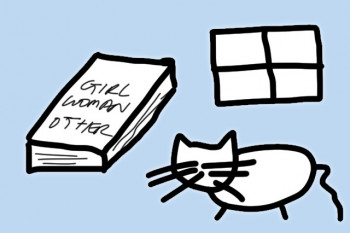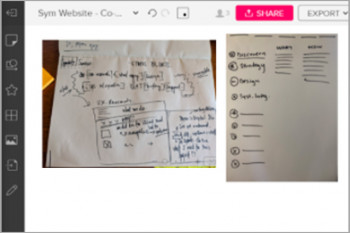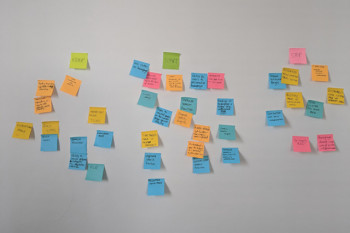Learnings from remote Co-Design
Published Sep 14, 2020, 5:53 PM
Written by Rachel Kelly
This article has been adapted from a talk given at the CSIRO Symposium: The Future of Meetings on the 15th of September 2020.
Introduction
On-site co-design workshops are a tactile, collaborative session that thrives on the energy from other attendees and the creative flow of pen on paper.
Moving that to an online environment where on-screen drawing tools and individuals in their own homes in a video meeting changes the dynamic completely. Tools to draw on screen are cumbersome and the opportunities to read the nonverbal queues are heavily reduced.
This article aims to give an overview of 'lessons learnt' from running numerous co-design sessions remotely over the last 6 months.
Co-Design: What, who and why?
What is Co-Design?
Co-Design sessions are workshops that bring together subject matter experts in order to co-create product or service solutions. Essentially everyone is a designer in co-design sessions and invited into the design process to contribute ideas.
Who are subject matter experts?
Subject matter experts can include stakeholders, real end-users who you may have already interviewed, or technical experts - basically, anyone who is an expert in the product or service you are designing.
Why run a co-design workshop?
Co-design workshops enable participants to feel deeply involved in the creation process, and this leads to better overall project engagement and smoother approval steps.
It can also act as an opportunity to identify areas of future change management such as champions of change or areas where more support or onboarding may be required closer to the product/ service release date.
Learnings from remote Co-Design
These tips are broad-ranging yet simple enough for you to pick up and try in your next workshop.
1. Don’t underestimate the power of a warm-up activity to help build trust
Building trust in an online setting builds the foundation for outcomes focussed co-design sessions, where all participants feel comfortable contributing their ideas.
One of my biggest learnings from lockdown is that unlike offline sessions where the opportunities to build 1on1 trust are broad-ranging - such as collecting participants from the foyer, walking with them to the meeting room while engaging in small talk - these opportunities are reduced online which means we need to ensure we make time for them in order to build trust so participants feel comfortable contributing their ideas and ensuring they know there is no such thing as a bad idea.
A simple and quick warm-up exercise I’ve been using at the beginning of a session is asking participants to sketch something they enjoyed about their weekend. This results in the sharing of ideas and also a realisation that there are some good things to come from lockdown, this I’ve found really builds rapport within the group
2. Selecting the right sketching tools, digital vs paper
In an offline setting post-it notes, sharpie pens and A3 sheets of paper is the norm it's fair to say moving co-design sessions online has meant introducing new tools and added complexity. However, I realised we still have a choice when it comes to selecting what tools to use.
Digital sketching
We’ve been using MURAL as our preferred co-design platform because:
- It's quick and easy for participants to join, as require no downloading or sign-in process
- Artefacts can be downloaded in a variety of file formats after the session
Hybrid approach - paper sketching and uploading to Mural
In a recent Co-Design workshop, we asked participants to bring a pen and paper and ensured they had access to mobile and desktop platforms. We then got them to:
- Sketch offline using paper and sharpie pen
- Upload hand-drawn sketches using their mobile to desktop
- Place the uploaded image into the mural board for discussion
Call me a traditionalist but so much of co-design is about the unresolved or imperfect ideas, that’s where you find the gems that ignite a conversation and spark an idea in the session. I’ve found when sketching online participants quickly find the erase button and while I’m not saying offline is better than online - it’s very hard to erase a sharpie!
3. Videos need to be on, this helps pick up the nonverbal queues
Presenting or facilitating to a screen of icons can be daunting especially as eye contact and body language like head nods and smiles are signs of engagement and help build rapport.
The lesson here is not to assume that participants’ default setting is to have their video and audio on the whole time, I’ve found the need to explicitly state this at the beginning. Explaining that it helps facilitate a good co-design session as non verbal queues have a greater chance of being picked up.
If internet connectivity is a problem with everyone's videos on and you need to free up band width, consider asking participants to tether from their mobile device which can often help OR suggest turning video off during sketching however communicate that videos must be on during discussion time.
4. Silence is golden, refrain from filling in the awkward silences
It’s not uncommon for the best insights to come during those in-between moments of discussion or as you're walking the participant out of the meeting room. The same can be said for online co-design sessions; however tempting it is to fill in awkward silence, give it time to play out.
I have found requesting audio to remain on for the duration of the session is also useful, as it allows silences to emerge organically and enables conversations and ideas to flow more naturally.
5. Retro's a good activity to get the idea juices flowing
I like to use the Keep, start, stop retro method which is well suited to virtual environments as it gives participants another opportunity to familiarise themselves with the tools on offer.
Participants are asked to think of how the product or service is currently and ask themselves what they would like it to keep doing, start doing and stop doing, writing their ideas onto a post it note and placing it under the corresponding title.
6. Good communication helps participants understand what's expected in the session
For those participants who are new to the Co-Design format, it's important to put their minds at ease by explaining the goals and agenda at the beginning of the session. I've found the need to be overly communicative during online sessions and have taken to:
- Stating the workshop goal at the beginning and circling back on it at the end of the session
- Specifying breaks for longer virtual co-design sessions
- Outlining the duration of each sketching activity and then discussion time
This communication builds trust and gets the best out of the session as participants understand the expectations.
7. Download artefacts straight away
The beauty of co-design sessions is that they produce co-created visual artefacts that will go on to inform the design phase of the project. Be sure to download and save all artefacts immediately after the session, as they will be highly valuable to use in future design briefs and reports.
Examples

Warm up activity example
A simple warm up activity is to ask participants to sketch and share something they enjoyed about their weekend, this builds trust and rapport among those in the room.

A hybrid approach to sketching
Moving co-design sessions online has meant the introduction of new tools which depending on the digital maturity of participants can add complexity. It's important to note you still have a choice when choosing digital over paper sketching, consider whether a hybrid approach is right for you.

Keep, start, stop retro activity
The keep, start, stop retro method is well suited to virtual environments and is a great activity to do before leading into sketching.
About the CSIRO Symposium
This CSIRO-hosted Future of Meetings Symposium was held over September 15-17, 2020, and brought together brilliant minds across a diverse range of industries and professions to discuss and share learnings adapting to virtual environments due to COVID-19.
Creating space for reflection, the conference aimed to start important conversations framed around the following questions:
"How do we make best use of existing and emerging collaborative technologies and what culture and practices are there and could there be that would help"?
"How do we maximise contributions and creativity, while minimising negative interactions or outcomes?"
It was a privilege to be involved in this event thanks to all who were involved in bringing the event together.
Hi I'm Rachel
"Co-Design is about co-creating solutions with the people who know the product or service the best. Everyone is a designer in a co-design session and I think every industry would benefit from applying its principles to their design process, as it is an inclusive approach that improves outcomes tenfold."
Rachel Kelly - UX/UI Designer - Rummikub board game enthusiast



